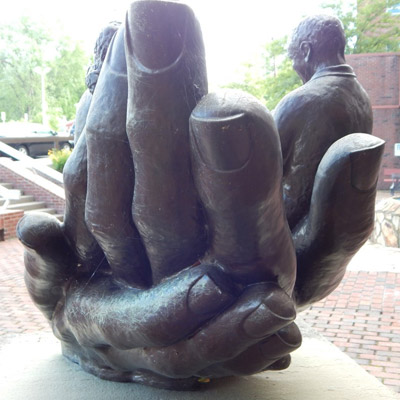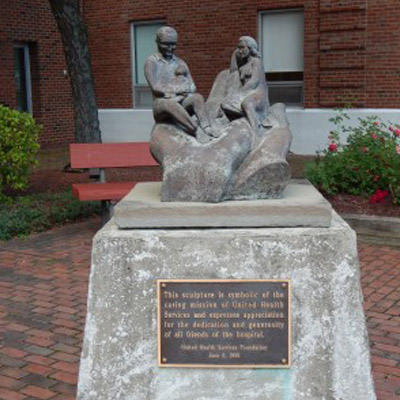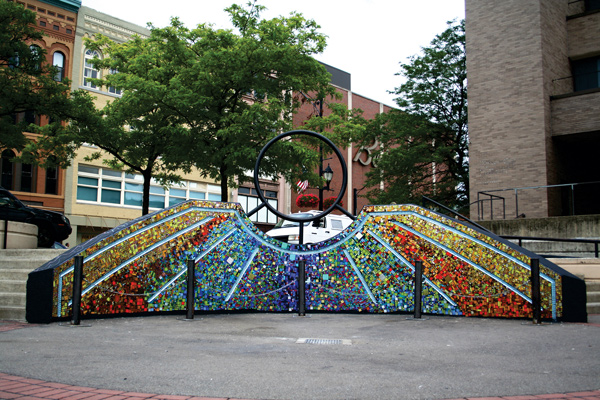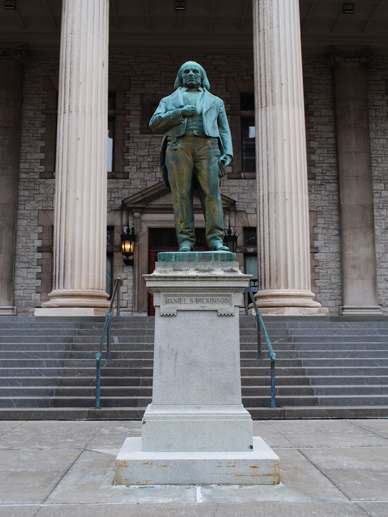Editor’s Note: Broome Arts Mirror reviewer Nancy Oliveri was unable to attend The Binghamton Theater Organ Society’s presentation of Ben-Hur at the Forum last Tuesday (April 8) and sent her sister in her stead.
Reviewed by Therese Bohn
Imagine playing two straight sets of music for about 75 minutes each with only a brief break in-between. This was the job of master organist Scott Foppiano, who joyously improvised accompaniment to the classic 1925 silent epic, Ben-Hur: a Tale of the Christ, this week at The Forum in Binghamton.
Watching silent movies on television is fun, but live music heightens the excitement of the story beyond adding a soundtrack. With every ripple and fanfare, Foppiano clearly showed that he knows this silent epic well, and he carried the film from its heights of glory to its deepest despair, without a single written note of music in front of him. Although most of his sets were improvised, he did incorporate parts of E. T. Paull’s Chariot Race of Ben-Hur March into that thrilling part of the film.
The march, which was written 31 years PRIOR to the making of the film, is like a polka and has an almost circus-like quality to it. For me, this seemed to clash with the dramatic action of the chariot race, but after all, the Roman games were held in the Circus Maximus, and the piece does capture the excitement of that venue. (Foppiano uses darker minor chords when Messala starts whipping Ben-Hur from his chariot, increasing the tension of the scene). In silent pictures, music makes the movie, and Foppiano’s performance was a joy to behold.
The film, Ben-Hur: a Tale of the Christ , based on the novel by General Lew Wallace, centers around Judah Ben-Hur, a young Jewish prince-turned-slave-turned-charioteer, whose life parallels that of Jesus. Judah faces the many hells of Roman oppression, and the (believed) loss of his beloved mother and sister, but triumphs in the end with the miracles of love and faith restoring his life and family. Judah was played by the incredibly handsome Ramón Novarro, who rivaled Rudolph Valentino among romantic leading men of the time. Francis X. Bushman played the beefy Roman, Messala, Judah’s childhood friend who becomes his enemy and sends Judah into slavery and his family into prison for the murder of the Roman ruler Gratus. (In truth, a brick fell by accident from the Hur home during a parade.) Judah’s mother, Miriam, and sister, Tirzah, played by Claire MacDowell and Kathleen Kay, suffer through prison and leprosy. Judah’s love, Esther, the dove-loving daughter of his family’s servant, Simonides (Migel de Brulier), is played by the sweet and highly ringlet-ed May McAvoy.
Being a silent film, of course, Ben Hur’s acting is melodramatic, with many popped eyes and grand gestures, so if you ever see it, don’t let that discourage you. In its simple style, the storytelling conveys the deepest of emotions with a quiet gesture, as when when Mary, the mother of Jesus, gently flicks a fly off the head of a sleeping baby, or in a heartbreaking scene, Miriam kisses the sleeping shadow of Judah, daring not to touch him for fear of spreading her leprosy. In that moment alone is the magic of silent filmmaking: to make an incredibly emotional statement through gestures alone. I actually heard weeping in the audience during this scene. When was the last time that happened to you at a multiplex?
Many of you may be familiar with the 1959 remake of Ben-Hur with Charlton Heston. Despite all the merits and Oscar wins of that spectacle, this 1925 version is more astonishing for its logistics alone. This was a primitive era of film, after all, with the earliest experiments of trick photography, but without the special effects of the remake and hardly the CGI of modern action extravaganzas. The lack of modern embellishments makes this Ben-Hur all the more astonishing. There are hundreds of horses, thousands of extra, and location filming in Los Angeles, Italy and North Africa. I was amazed by the hours of time, talent and money it must have taken to create this movie. It is a masterpiece.
The monochromatic film has occasional scenes, mostly involving Jesus, in primitive two-color Technicolor (blue and red). We never see the face of Jesus himself, only his arm or foot — at a distance or cleverly obscured by another character. (e.g., The Last Supper scene recreates DaVinci’s famous tableau but places the traitorous apostle, Judas, at the center front of the table, directly hiding Jesus). Come to think of it, I don’t remember seeing more than a suggestion of Jesus in any movie before 1961’s King of Kings with the dishy Jeffrey Hunter as Jesus. As late as 1953, in the film The Robe, he was still portrayed anonymously. I wondered if it was this Ben-Hur that started that trend.
But the most amazing feats of movie magic, filmed by directors Fred Niblo and Charles Brabin, are the truly massive sets and props built for the pirate battle and the chariot race. The battle required two actual fleets of ancient ships, Roman and pirate, which actually fought and destroyed each other in the scenes you see. Designers Cedric Gibbons and Horace Jackson and their production crew took two years to construct the magnificent Circus Maximus, whose giant brooding statues were reused in the 1959 version, and whose stands were filled with 10,000 extras.
The costumes by Hermann J. Kaufmann are both glamorous and whimsical. As charioteers, Messala wears a winged helmet a la Mercury while Judah’s headgear is more like a leather football helmet. An Egyptian siren who woos Judah wears a skimpy sheath whose skirt is reminiscent of a mermaid’s, and her wig a great white mop of a flapper bob.
All the hard work that went into this production pays off, and you are truly transported into this ancient world. I cannot recommend this great silent epic enough. If it doesn’t whet your appetite for more silent greats, I don’t know what will, and I encourage the Binghamton Theater Organ Society to bring us more.
What a treasure to have this group present these wonderful showcases of the theater organ with classic film. I can’t think of a better way to introduce Millennials to the true awesomeness of early cinema. Be sure to check out the Society’s web site (BinghamtonTOS.org) for future programs.
NOTE: If you missed the presentation at The Forum, Turner Classic Movies (TCM, TWC Channel 63) will be broadcasting Ben-Hur: A Tale of the Christ at 6 a.m. Thursday, April 17. Set your DVR.



































